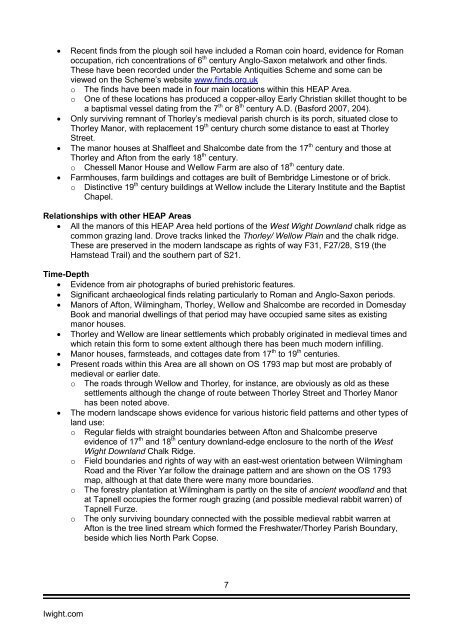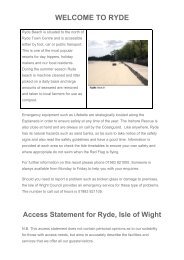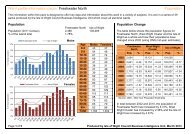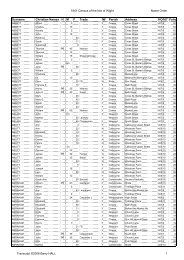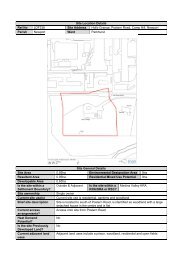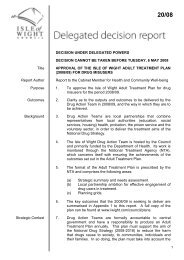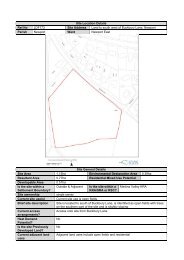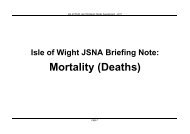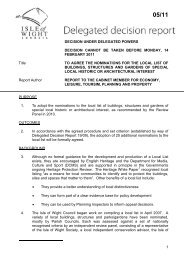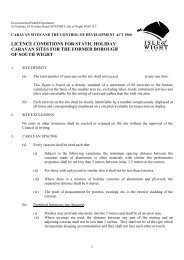Thorley Wellow Plain HEAP - Isle of Wight Council
Thorley Wellow Plain HEAP - Isle of Wight Council
Thorley Wellow Plain HEAP - Isle of Wight Council
- No tags were found...
Create successful ePaper yourself
Turn your PDF publications into a flip-book with our unique Google optimized e-Paper software.
• Recent finds from the plough soil have included a Roman coin hoard, evidence for Romanoccupation, rich concentrations <strong>of</strong> 6 th century Anglo-Saxon metalwork and other finds.These have been recorded under the Portable Antiquities Scheme and some can beviewed on the Scheme’s website www.finds.org.ukooThe finds have been made in four main locations within this <strong>HEAP</strong> Area.One <strong>of</strong> these locations has produced a copper-alloy Early Christian skillet thought to bea baptismal vessel dating from the 7 th or 8 th century A.D. (Basford 2007, 204).• Only surviving remnant <strong>of</strong> <strong>Thorley</strong>’s medieval parish church is its porch, situated close to<strong>Thorley</strong> Manor, with replacement 19 th century church some distance to east at <strong>Thorley</strong>Street.• The manor houses at Shalfleet and Shalcombe date from the 17 th century and those at<strong>Thorley</strong> and Afton from the early 18 th century.o Chessell Manor House and <strong>Wellow</strong> Farm are also <strong>of</strong> 18 th century date.• Farmhouses, farm buildings and cottages are built <strong>of</strong> Bembridge Limestone or <strong>of</strong> brick.o Distinctive 19 th century buildings at <strong>Wellow</strong> include the Literary Institute and the BaptistChapel.Relationships with other <strong>HEAP</strong> Areas• All the manors <strong>of</strong> this <strong>HEAP</strong> Area held portions <strong>of</strong> the West <strong>Wight</strong> Downland chalk ridge ascommon grazing land. Drove tracks linked the <strong>Thorley</strong>/ <strong>Wellow</strong> <strong>Plain</strong> and the chalk ridge.These are preserved in the modern landscape as rights <strong>of</strong> way F31, F27/28, S19 (theHamstead Trail) and the southern part <strong>of</strong> S21.Time-Depth• Evidence from air photographs <strong>of</strong> buried prehistoric features.• Significant archaeological finds relating particularly to Roman and Anglo-Saxon periods.• Manors <strong>of</strong> Afton, Wilmingham, <strong>Thorley</strong>, <strong>Wellow</strong> and Shalcombe are recorded in DomesdayBook and manorial dwellings <strong>of</strong> that period may have occupied same sites as existingmanor houses.• <strong>Thorley</strong> and <strong>Wellow</strong> are linear settlements which probably originated in medieval times andwhich retain this form to some extent although there has been much modern infilling.• Manor houses, farmsteads, and cottages date from 17 th to 19 th centuries.• Present roads within this Area are all shown on OS 1793 map but most are probably <strong>of</strong>medieval or earlier date.o The roads through <strong>Wellow</strong> and <strong>Thorley</strong>, for instance, are obviously as old as thesesettlements although the change <strong>of</strong> route between <strong>Thorley</strong> Street and <strong>Thorley</strong> Manorhas been noted above.• The modern landscape shows evidence for various historic field patterns and other types <strong>of</strong>land use:ooooRegular fields with straight boundaries between Afton and Shalcombe preserveevidence <strong>of</strong> 17 th and 18 th century downland-edge enclosure to the north <strong>of</strong> the West<strong>Wight</strong> Downland Chalk Ridge.Field boundaries and rights <strong>of</strong> way with an east-west orientation between WilminghamRoad and the River Yar follow the drainage pattern and are shown on the OS 1793map, although at that date there were many more boundaries.The forestry plantation at Wilmingham is partly on the site <strong>of</strong> ancient woodland and thatat Tapnell occupies the former rough grazing (and possible medieval rabbit warren) <strong>of</strong>Tapnell Furze.The only surviving boundary connected with the possible medieval rabbit warren atAfton is the tree lined stream which formed the Freshwater/<strong>Thorley</strong> Parish Boundary,beside which lies North Park Copse.7Iwight.com


